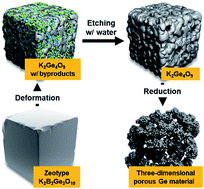Intramolecular deformation of zeotype-borogermanate toward a three-dimensional porous germanium anode for high-rate lithium storage†
Abstract
We demonstrate a new class of synthetic process for three-dimensional porous Ge materials (3D-pGe). Starting from zeotype-borogermanate microcubes, the 3D-pGe sample was synthesized through a thermal deformation of artificial Ge-rich zeolite, etching, and subsequent hydrogen reduction. After the synthesis, the resultant byproducts were simply removed by warm water instead of a harmful etchant such as hydrofluoric acid. Benefiting from the structural advantages with meso/macro porosity in the overall framework, the as-prepared 3D-pGe exhibits good electrochemical properties as anode materials for lithium-ion batteries with a high capacity (770 mA h g−1), cycling stability (capacity retention over 83%) after 250 cycles at 1C, and excellent rate capability (32% for 10C with respect to C/5) as well as pseudocapacitive contribution by surface-controlled reaction. This study paves the way to a new synthesis strategy of 3D porous Ge anode materials from zeolite for large-scale energy storage applications.



 Please wait while we load your content...
Please wait while we load your content...